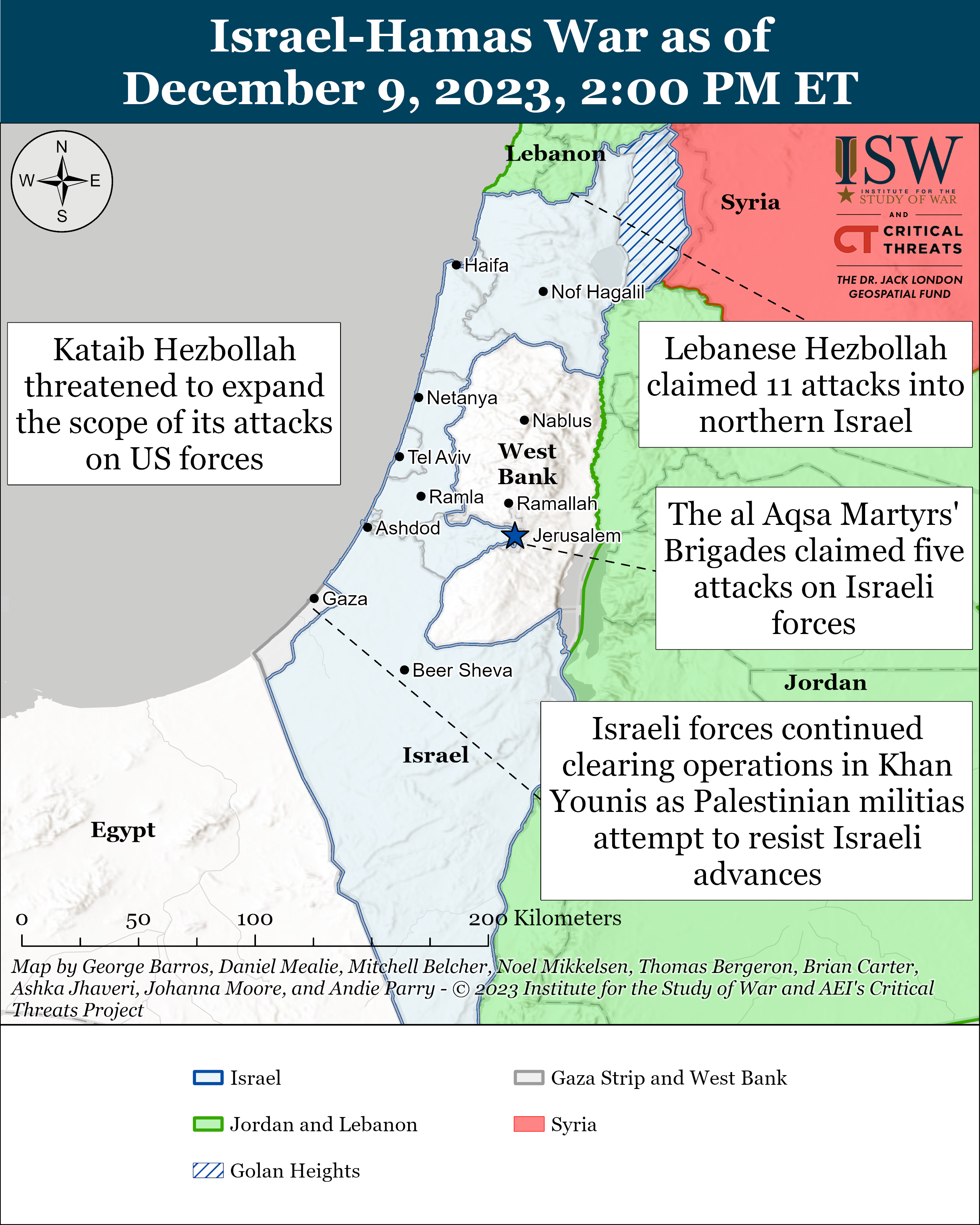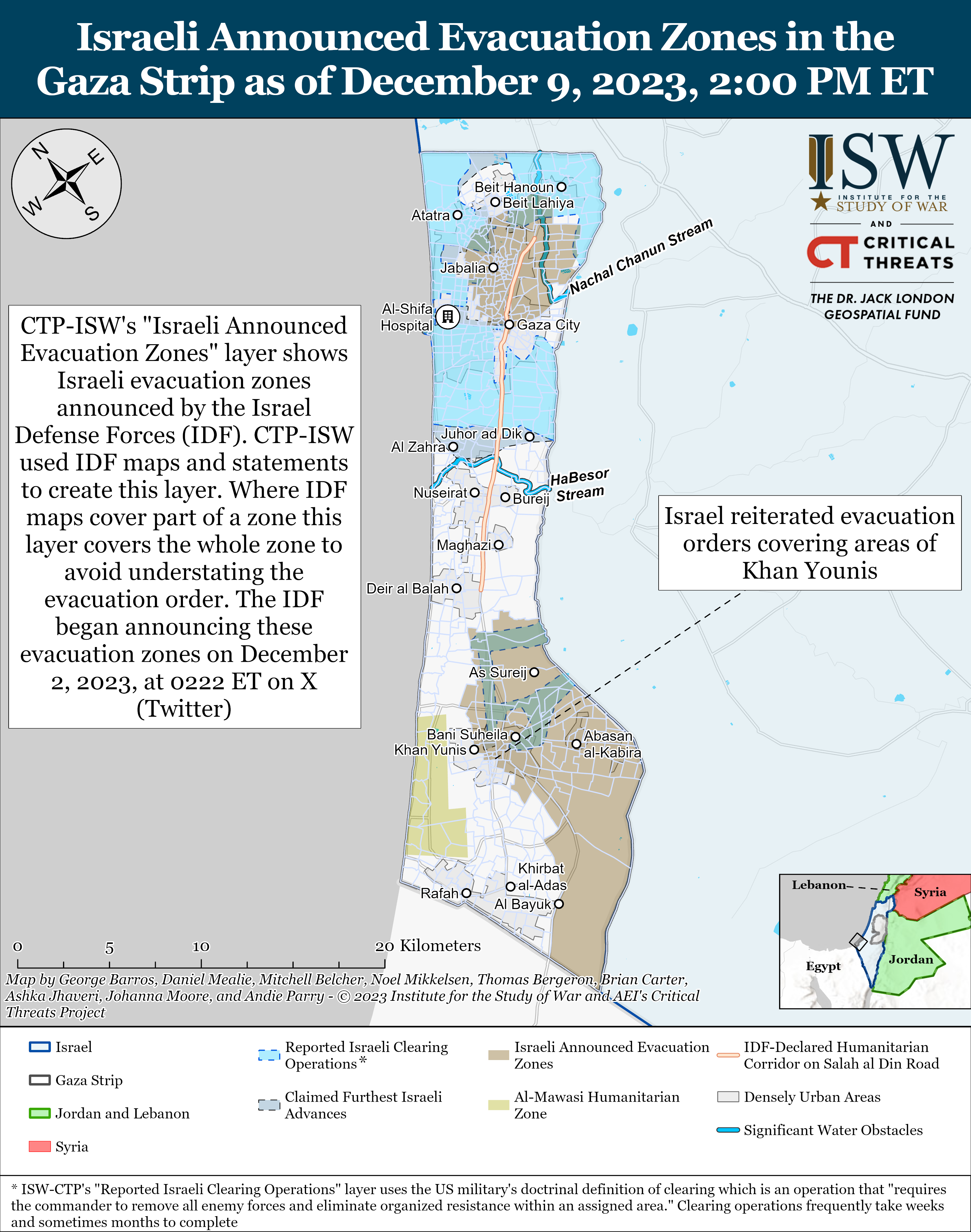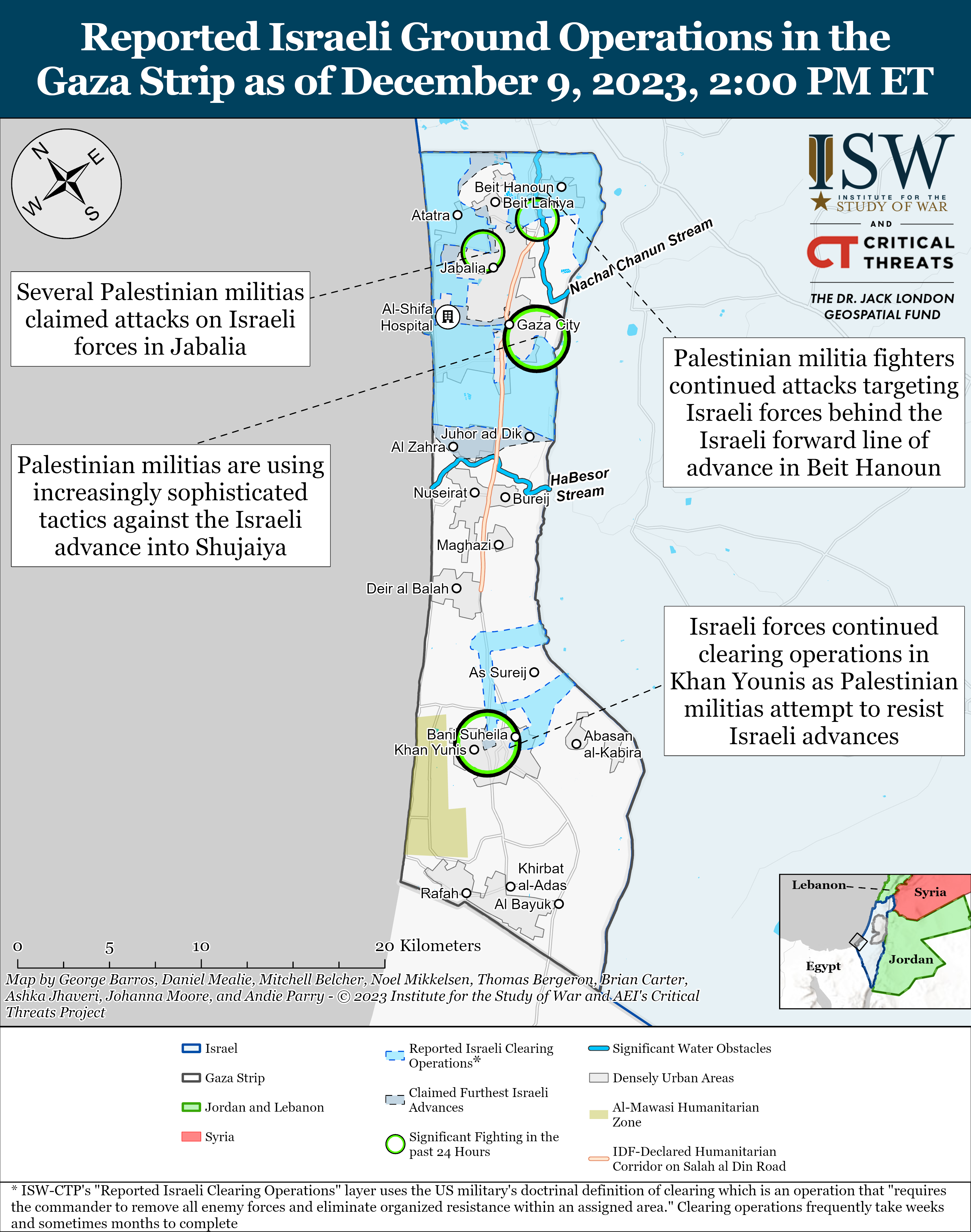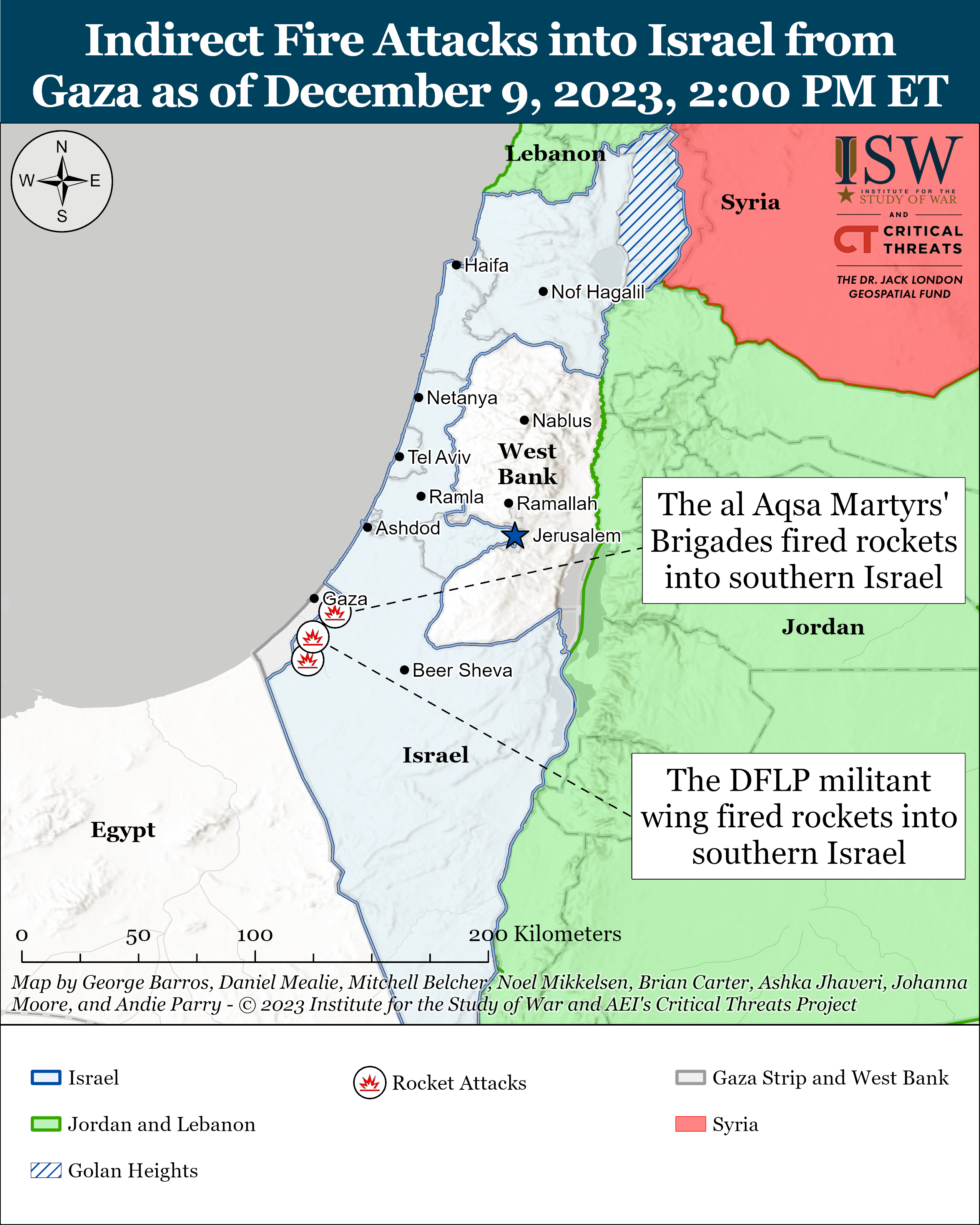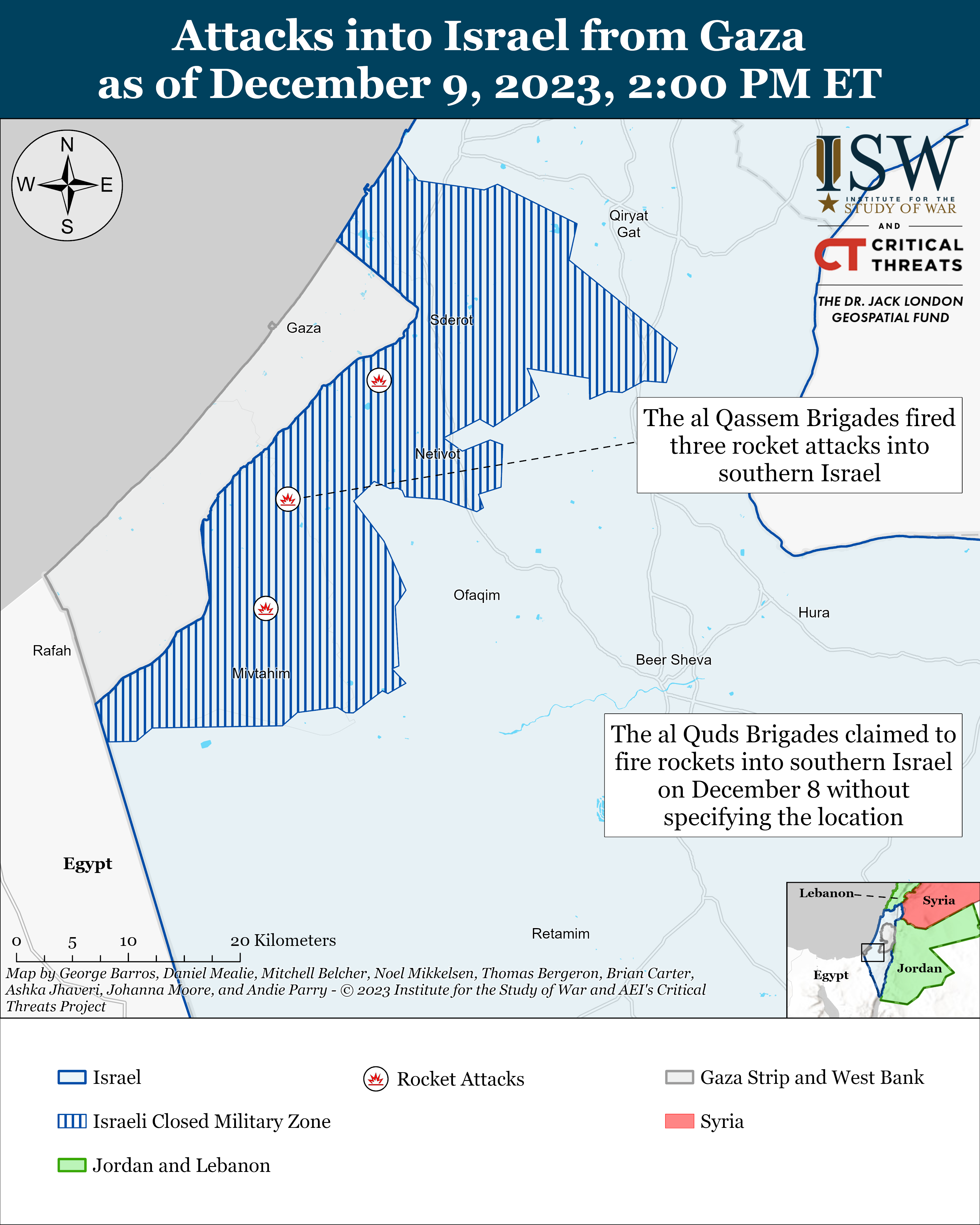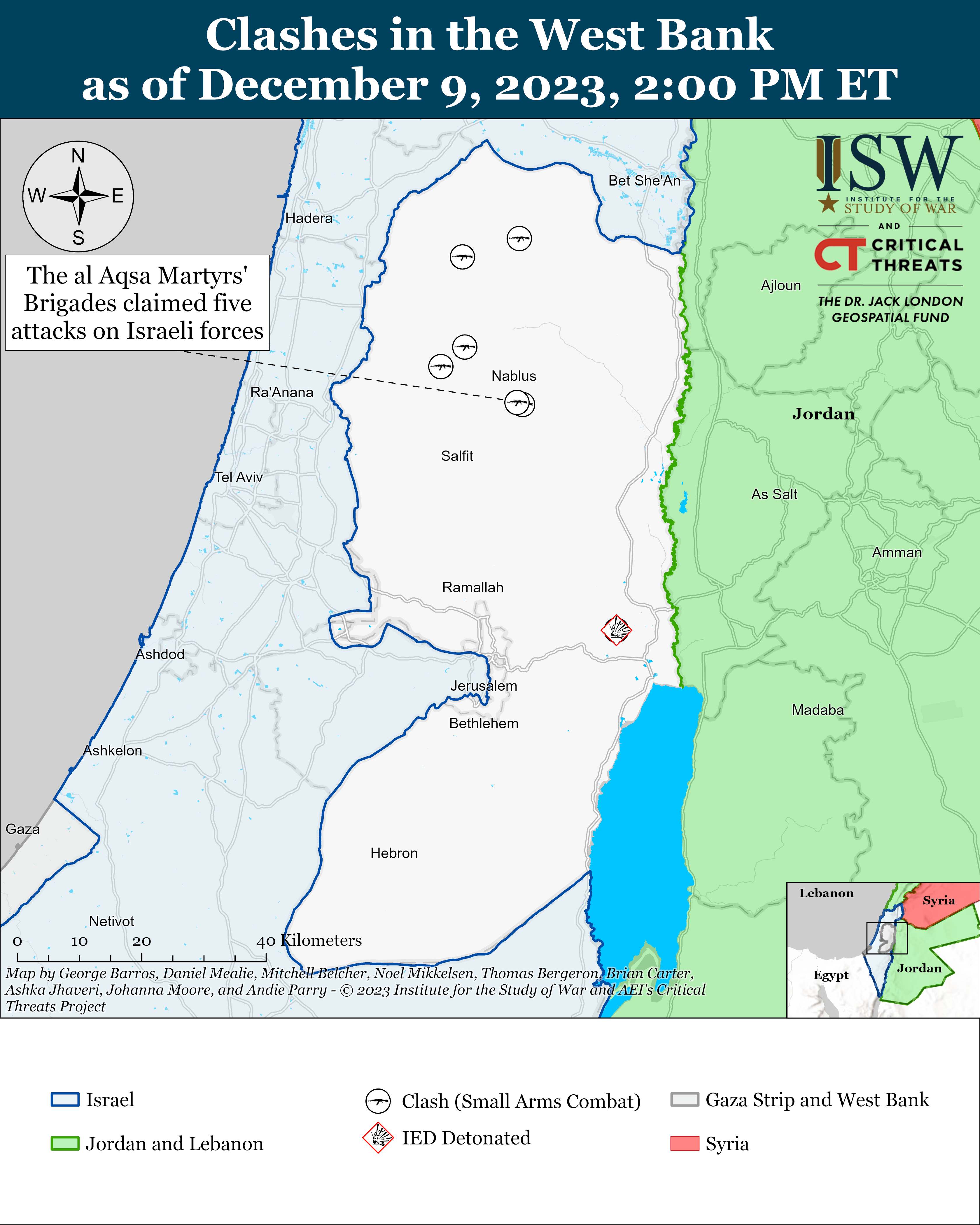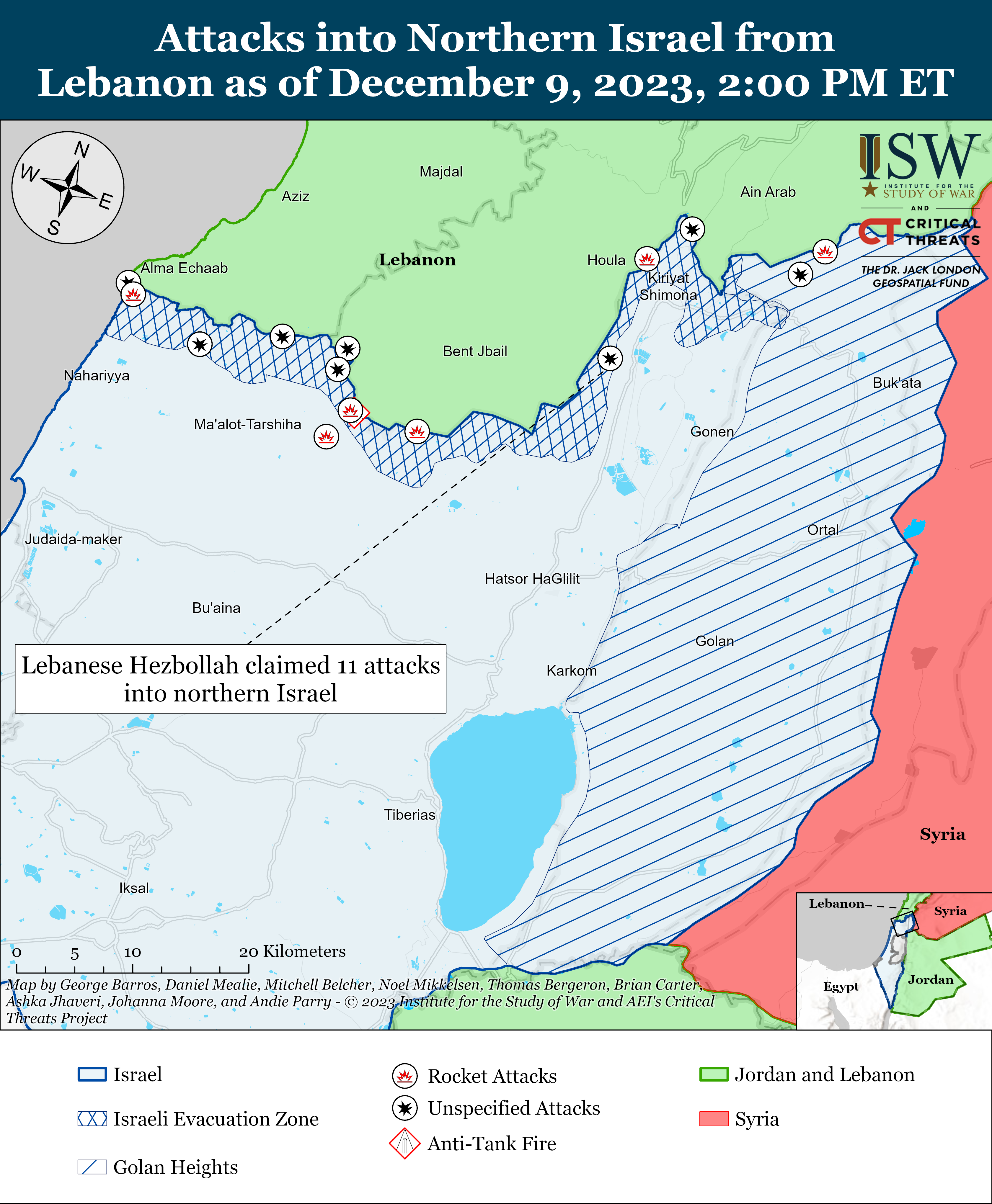Iran Update, December 9, 2023
Ashka Jhaveri, Amin Soltani, Johanna Moore, and Nicholas Carl
Information Cutoff: 2:00 pm EST
The Iran Update provides insights into Iranian and Iranian-sponsored activities abroad that undermine regional stability and threaten US forces and interests. It also covers events and trends that affect the stability and decision-making of the Iranian regime. The Critical Threats Project (CTP) at the American Enterprise Institute and the Institute for the Study of War (ISW) provides these updates regularly based on regional events. For more on developments in Iran and the region, see our interactive map of Iran and the Middle East.
Note: CTP and ISW have refocused the update to cover the Israel-Hamas war. The new sections address developments in the Gaza Strip, the West Bank, Lebanon, and Syria, as well as noteworthy activity from Iran’s Axis of Resistance. We do not report in detail on war crimes because these activities are well-covered in Western media and do not directly affect the military operations we are assessing and forecasting. We utterly condemn violations of the laws of armed conflict and the Geneva Conventions and crimes against humanity even though we do not describe them in these reports.
Click here to see CTP and ISW’s interactive map of Israeli ground operations. This map is updated daily alongside the static maps present in this report.
Key Takeaways:
- Israeli forces continued clearing operations in Khan Younis as Palestinian militias attempt to resist Israeli advances. The al Qassem Brigades—the militant wing of Hamas—claimed several attacks on Israeli forces and vehicles in the southern Gaza Strip.
- Israeli forces clashed with Palestinian militias in Shujaiya neighborhood and Jabalia city as Israeli forces advanced in the northern Gaza Strip. Israel reported that Hamas is stealing supplies from civilians in Shujaiya neighborhood.
- Palestinian militia fighters are continuing their attacks against the IDF behind the Israeli forward line of advance, which is consistent with the nature of clearing operations.
- The IDF spokesperson for Arab media posted specific evacuation orders covering areas of Khan Younis on X (Twitter).
- Palestinian militias conducted at least five indirect fire attacks from the Gaza Strip into Israeli territory.
- Israeli forces clashed with Palestinian fighters at least seven times in the West Bank.
- Lebanese Hezbollah and other Iranian-backed militias conducted 16 attacks into northern Israel from Lebanon.
- The Islamic Resistance in Iraq—a coalition of Iranian-backed Iraqi militias—claimed that it conducted 11 “operations” against US forces in Iraq and Syria on December 8. Kataib Hezbollah later stated it plans to increase the scope of its attacks on US targets in Iraq.
- Houthi military spokesperson Brigadier General Yahya Sarea announced that the Houthis will expand their attacks on maritime traffic around the Red Sea to include all vessels traveling to Israel, regardless of their national affiliation.
- Senior Iranian officials discussed the Israel-Hamas war with Syrian Prime Minister Hussein Arnous in Tehran.
Gaza Strip
Axis of Resistance campaign objectives:
- Erode the will of the Israeli political establishment and public to launch and sustain a major ground operation into the Gaza Strip
- Degrade IDF material and morale around the Gaza Strip.
Israeli forces continued clearing operations in Khan Younis as Palestinian militias attempt to resist Israeli advances. Israeli forces located several tunnel shafts and a Hamas military headquarters as they advanced in Khan Younis.[1] The Israel Defense Forces (IDF) engaged three Palestinian fighters as they emerged from a tunnel in central Khan Younis and fired a rocket-propelled grenade (RPG).[2] Hamas maintains an extensive tunnel system across the Gaza Strip, which Israeli forces have destroyed as they have advanced. Israeli forces also raided a mosque from which Hamas fighters were operating. The IDF said the Hamas fighters detonated an IED near Israeli forces.[3]
The al Qassem Brigades—the militant wing of Hamas—claimed several attacks on Israeli forces and vehicles in the southern Gaza Strip on December 9. The militia fighters primarily used RPGs, tandem charge anti-tank rockets, IEDs, and small arms to engage Israeli forces and vehicles.[4] The al Quds Brigades—the militant wing of Palestinian Islamic Jihad (PIJ)—claimed to target nine military vehicles, two armored personnel carriers, and a bulldozer across the entire Gaza Strip, including around Deir al Balah and Khan Younis.[5] The al Quds Brigades also claimed to trap Israeli forces in a building and then fire RPGs at them.[6]
Palestinian militias continued conducting mortar and rocket attacks on Israeli forces in the southern Gaza Strip. The al Quds Brigades fired mortars and rockets at Israeli forces in Khan Younis city and along the Israeli forward line of advance in eastern Khan Younis.[7] The al Qassem Brigades separately claimed three successive mortar attacks on Israeli forces.[8]
Israeli forces clashed with Palestinian militias in Shujaiya neighborhood and Jabalia city as Israeli forces advanced in the northern Gaza Strip.
- Israeli forces clashed with Palestinian militias near a school in Shujaiya neighborhood of Gaza city.[9] The forces uncovered small arms, grenades, and ammunition inside the classrooms, which is consistent with the IDF’s repeated reports that Hamas uses civilian infrastructure for military activity.[10] The al Quds Brigades claimed to use an explosively formed penetrator (EFP) to destroy an IDF tank in Shujaiya.[11] Hamas and other Palestinian militias have increasingly used EFPs, which are particularly lethal improvised explosive devices designed to penetrate armored vehicles, since the humanitarian pause ended on December 1.[12] The use of EFPs is part of a larger shift in which Hamas and PIJ are using increasingly sophisticated tactics against Israeli forces in the Gaza Strip.[13] The al Quds Brigades separately claimed to target three tanks with tandem-charged anti-tank rockets in the same neighborhood.[14] The al Qassem brigades claimed that it conducted two house-borne improvised explosive device (HBIED) attacks targeting Israeli forces southwest of Shujaiya in Zaytoun neighborhood of Gaza city.[15] The Palestinian militia attacks are consistent with Israeli media reporting that Hamas members have not fled and are fighting fiercely in Shujaiya neighborhood.[16]
- Israeli forces raided a series of buildings in Jabalia containing Hamas fighters and weapons and advanced to al Sheikh Radwan Pool southwest of Jabalia city.[17] The Israeli forces called in a drone strike to support their maneuvers in the city.[18] The al Quds Brigades and al Qassem Brigades claimed various attacks using mortars, RPGs, and anti-tank munitions against Israeli forces west of Jabalia.[19] The Abu Ali Mustafa Brigades—the militant wing of Popular Front for the Liberation of Palestine (PFLP)—claimed that its fighters clashed with Israeli forces on the outskirts of the Jabalia refugee camp.[20]
An IDF spokesperson reported on December 9 that Palestinian fighters in Shujaiya and Jabalia surrendered to the IDF and handed over their weapons and equipment.[21] Israeli media aired footage of several Palestinian men surrendering in front of Israeli forces.[22] The IDF spokesperson accused the leader of Hamas in the Gaza Strip, Yahya Sinwar, of being out of touch with the reality of the situation in the field.[23]
Israel reported that Hamas is stealing supplies from civilians in Shujaiya neighborhood. The IDF spokesperson for Arab media published drone footage of Hamas personnel beating residents and stealing food and humanitarian supplies in the neighborhood.[24]
Palestinian militia fighters are continuing their attacks against the IDF behind the Israeli forward line of advance, which is consistent with the nature of clearing operations. Palestinian militia fighters fired at Israeli forces from civilian infrastructure in Beit Hanoun.[25] The al Quds Brigades claimed to fire RPGs at two military vehicles in Beit Hanoun on December 9.[26] Fighting behind the Israeli forward line of advance is consistent with the doctrinal definition of “clear,” which is a tactical task that “requires the commander to remove all enemy forces and eliminate organized resistance within an assigned area.”
The IDF Arabic-language spokesperson posted evacuation orders covering specific areas in Khan Younis on X (Twitter) at 08:57 EST on December 9. The orders highlight specific blocks and neighborhoods in al Katiba, al Mahatta, and the city center of Khan Younis.[27] The evacuation notices called for civilians to go to “known shelters” west of Khan Younis.[28] The IDF previously published a map covering the same areas in Khan Younis on December 4.[29]
Palestinian militias conducted at least five indirect fire attacks from the Gaza Strip into Israeli territory. The al Quds Brigades claimed on December 8 to fire rockets at Israeli towns in southern Israel without specifying the locations.[30] The al Qassem Brigades conducted three rocket attacks into southern Israel.[31] The al Aqsa Martyrs’ Brigades—the self-proclaimed militant wing of Fatah—conducted a rocket attack on an Israeli town near the Gaza Strip.[32] The National Resistance Brigades—the militant wing of the Democratic Front for the Liberation of Palestine—conducted one rocket attack into southern Israel.[33] An IDF spokesperson reported on December 9 that Hamas has continued to fire rockets from the Israel-declared humanitarian zone west of Khan Younis.[34] The spokesperson referenced two rocket attacks on December 8, which fell short of Israeli territory.[35]
Recorded reports of rocket attacks; CTP-ISW cannot independently verify impact.
Recorded reports of rocket attacks; CTP-ISW cannot independently verify impact.
West Bank
Axis of Resistance campaign objectives:
- Draw IDF assets and resources toward the West Bank and fix them there
Israeli forces clashed with Palestinian fighters at least seven times in the West Bank on December 9. The al Aqsa Martyrs’ Brigades claimed three simultaneous shootings on Israeli forces at the Deir Sharaf and Awarta checkpoints and Hatmar Shomron.[36] The al Aqsa Martyrs’ Brigades also clashed with Israeli forces around Jericho and Kafr Rai.[37] The al Aqsa Martyrs’ Brigades threw an IED at Israeli forces in the clashes near Jericho.[38]
A funeral was held in Tubas on December 9 for a Palestinian fighter that died in clashes with Israel forces. At least 100 individuals attended the funeral, some of whom wore Hamas and PIJ headbands and carried the militias’ flags.[39] The funeral procession chanted ”sword against sword, we are Mohammad Deif’s men,” referring to the commander of the al Qassem Brigades.[40] The presence of PIJ personnel is noteworthy in that context. The Lions’ Den—a West Bank-based militia—has similarly expressed allegiance to Mohammad Deif in recent weeks, as CTP-ISW previously reported.[41]
This map is not an exhaustive depiction of clashes and demonstrations in the West Bank.
Southern Lebanon and Golan Heights
Axis of Resistance campaign objectives:
- Draw IDF assets and resources toward northern Israel and fix them there
- Set conditions for successive campaigns into northern Israel
Lebanese Hezbollah (LH) and other Iranian-backed militias conducted 16 attacks into northern Israel from Lebanon on December 9.[42] This rate of attacks is consistent with the daily average. LH claimed 11 of the attacks on Israeli forces.[43] Unidentified Iranian-backed fighters separately claimed five rocket attacks.[44]
Iran and Axis of Resistance
Axis of Resistance campaign objectives:
- Demonstrate the capability and willingness of Iran and the Axis of Resistance to escalate against the United States and Israel on multiple fronts
- Set conditions to fight a regional war on multiple fronts
The Islamic Resistance in Iraq—a coalition of Iranian-backed Iraqi militias—claimed that it conducted 11 “operations” against US forces in Iraq and Syria on December 8.[45] Western media previously reported that unspecified militants conducted nine attacks on US forces in Iraq and Syria and one attack on the US Embassy in Baghdad on December 8, marking 10 attacks in total.[46] It is unclear why the Islamic Resistance in Iraq reported one ”operation” more than the number of attacks that Western media reported. It is possible that the Islamic Resistance in Iraq is using the term ”operation” more broadly than to refer to just attacks.
Kataib Hezbollah (KH) stated that it plans to increase the scope of its attacks on US targets in Iraq on December 9.[47] KH spokesperson Abu Ali al Askari congratulated the Islamic Resistance in Iraq, of which KH is a member, on its attack on the US Embassy in Baghdad on December 8 and warned that the attack marked a new standard for attacks against the United States in Iraq.[48] Askari claimed that the US Embassy in Baghdad was a base for planning military and security operations disguised as a diplomatic mission.[49] By referring to the US embassy as a military target, KH is setting informational conditions to justify attacks on the embassy. Askari’s statement comes after the Islamic Resistance in Iraq escalated significantly its attack campaign, conducting around 10 attacks on US personnel in Iraq and Syria on December 8. Askari also said that KH will consider Iraqi security forces that cooperate with the United States as accomplices to US “crimes,” suggesting that KH may attack these Iraqi security personnel as well. Unidentified militants conducted a rocket attack on the Iraqi National Security Service (NSS) headquarters on December 8, damaging the facility, according to the NSS spokesperson.[50]
Askari claimed that its attacks are meant to expel US forces from Iraq.[51] This framing is consistent with CTP-ISW’s assessment that Iranian-backed Iraqi actors are conducting a campaign to expel the United States from Iraq with military and political pressure.
US Secretary of Defense Lloyd Austin reaffirmed that the United States has the right to retaliate against Iranian-backed terror organizations for attacks on US personnel during a phone call with Iraqi Prime Minister Mohammad Shia al Sudani on December 9.[52] Austin’s call with Sudani comes after the Islamic Resistance in Iraq escalated its attack campaign on December 8. Austin stated that the US-designated terrorist organizations KH and Harakat Hezbollah al Nujaba (HHN) have conducted the majority of attacks on coalition personnel since the Israel-Hamas war began.[53] Austin and Sudani also discussed the Iraqi central government’s obligation to ensure the security of US and coalition personnel, advisers, and facilities.[54]
Sudani ordered the establishment of a working group to investigate the December 8 rocket attacks on the US Embassy in Baghdad and NSS headquarters.[55] Sudani granted the team “broad powers” to confront any threats to the security of diplomatic missions in Iraq.[56] Iraqi military spokesperson Yahya Rasoul claimed that the team will work with local authorities to identify and arrest individuals responsible for the attacks.[57]
Houthi military spokesperson Brigadier General Yahya Sarea announced on December 9 that the Houthis will expand their attacks on maritime traffic around the Red Sea to include all vessels traveling to Israel, regardless of their national affiliation.[58] Sarea said that ”if Gaza does not receive the food and medicine it needs, all ships in the Red Sea bound for Israeli ports, regardless of their nationality, will become a target for our armed forces.”[59] The United Nations reported on December 8 the delivery of food, medical supplies, and water, among other aid shipments, to the Gaza Strip.[60] It is therefore unclear on what exactly Sarae is conditioning the end of Houthi attacks and whether he is calling for more aid to go to the Gaza Strip. Sarae’s announcement follows several Houthi attacks against Israeli-owned ships and US naval vessels around the Bab al Mandeb in recent weeks.[61]
Sarea’s announcement is consistent with recent Western media reporting that the Houthis—with Iranian support—plan to expand their attacks on maritime traffic around Yemen. The New York Times reported on December 8 that Iran’s so-called “Axis of Resistance” plans to increase attacks on US and Israeli assets in the Middle East, including Houthi attacks on American-owned vessels operating in the Red Sea.[62] The New York Times also reported that Iran operates an intelligence gathering ship in the Red Sea that helps the Houthis identify vessels to attack. This report is probably referring to the Behshad, which is a military vessel that Iran operates off the Dahlak archipelago.[63] US Deputy National Security Adviser John Finer similarly stated on December 7 that the IRGC is involved in planning and executing the Houthis’ drone and missile attacks on ships in the Red Sea.[64]
Senior Iranian officials discussed the Israel-Hamas war with Syrian Prime Minister Hussein Arnous in Tehran on December 9. Iranian First Vice President Mohammad Mokhber called for an end to American and Israeli “crimes” in the Gaza Strip and criticized international institutions for their inaction during his meeting with Arnous.[65] Iranian Parliament Speaker Mohammad Bagher Ghalibaf praised Hamas’ October 7 attack as major turning point for Iran’s so-called ”Axis of Resistance” during his meeting with Arnous.[66] Arnous will later meet with Iranian President Ebrahim Raisi and Supreme National Security Council Secretary Rear Admiral Ali Akbar Ahmadian during his visit to Tehran.[67]
Iranian Foreign Affairs Minister Hossein Amir Abdollahian discussed the Israel-Hamas war during a phone call with German Foreign Affairs Minister Alena Burbok on December 9.[68] Abdollahian emphasized the need for finding an immediate political solution to the conflict.
Iran is continuing to pressure the United States and Israel into establishing a permanent ceasefire by warning that failing to do so will precipitate an escalation of the Israel-Hamas war. Iranian Foreign Affairs Minister Hossein Amir Abdollahian warned that war would likely expand and the “region could explode out of hand” if the United States and Israel continue to support the military operation into the Gaza Strip during a phone call with UN Secretary General Antonio Guterres on December 9. Iranian Armed Forces General Staff Chief Major General Mohammad Bagheri similarly warned Israel against continuing its “crimes” against Palestinians in the Gaza Strip on December 9. These statements are consistent with previous Iranian rhetoric surrounding the Israel-Hamas war, which CTP-ISW has previously reported.[69]


